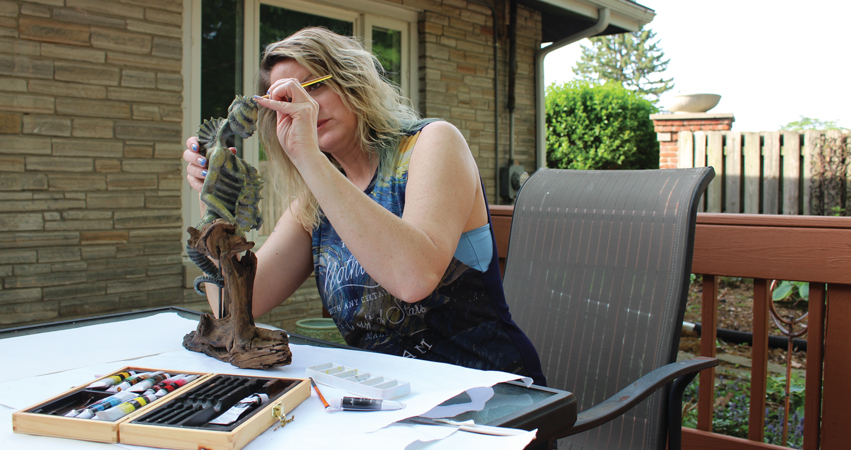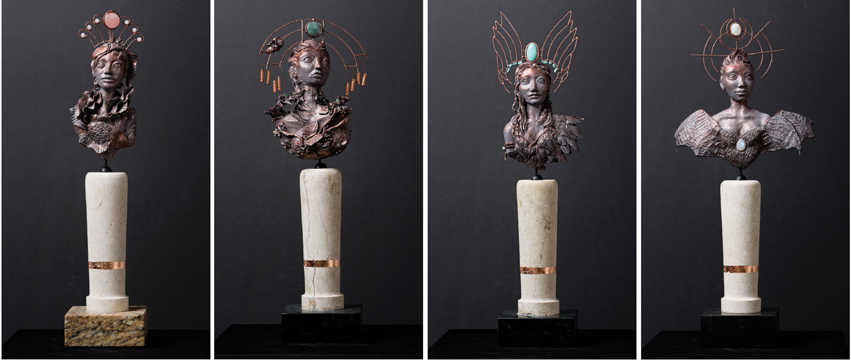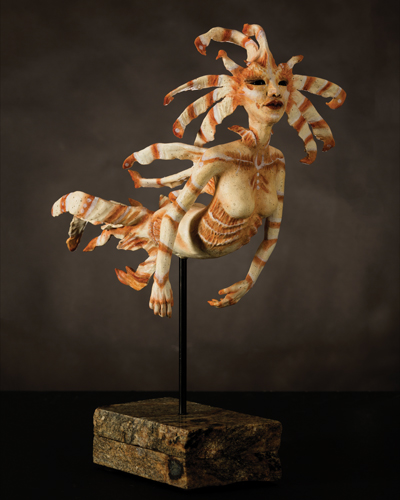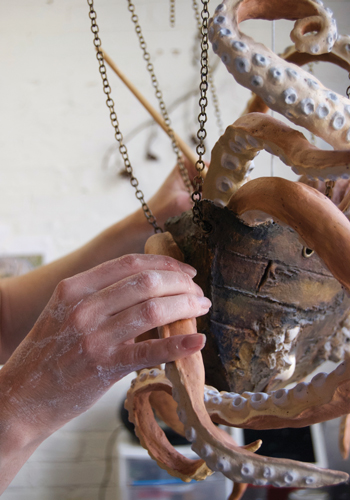A surreal and magical world mirrors the beauty of nature through fairytale-like imagery.
Nikole Cooney sits in her East Peoria home, windows open, inviting the space to be filled with birdsong. “I love to create an environment that is immersive,” she notes, speaking about her very distinctive artwork. “Some say they feel like they’ve stepped into another world. I love that—and it’s intentional.”
It’s springtime. Outside the oak trees are pollinating, showering the forest floor with strands of gold. A pair of trees creak against one another, creating an otherworldly, discordant sound.
“I want to create an escape to this magical place,” she explains. “And what I don’t think people realize is that it’s not an escape from reality, it’s an escape to reality.”
Out of the Woods
Born and raised in the small village of Green Valley in rural Tazewell County, Cooney spent her childhood exploring the outdoors and planting flowers in the garden with her grandmother. “I was always in the woods,” she recalls. She also showed an early proclivity for creating art. “I always doodled and sketched… I can’t remember a time when I didn’t do that. As I got older, I took every art class and project I could get my hands on.”
She received her first oil painting set in high school—a simple act which Cooney says changed the course of her life. “That ignited such a lust for creating. That was when I caught ‘the bug.’”
Her love for art was matched only by her fondness for wildlife and nature. A quick glance at her earliest sketches and paintings reveals a young artist who rarely drew figures, instead focusing on animals. “I thought I was just going to go out into the woods and paint animals,” she says with a laugh, “and National Geographic was going to come and support the whole thing!”

The artist at work in the backyard of her East Peoria home
Approaching her high school graduation, she faced a difficult decision: pursue her art full-time and risk poverty, or find a career that would ground her financially. “I had such a passion for my art even then, but the practicality of making a living at it… You just didn’t hear about people doing that like you can these days.”
Embracing her love for animals, Cooney pursued her undergraduate degree in veterinary technology. Yet she found herself gravitating back towards creative work, taking every art class she could fit into her schedule. “I was pushing to get this degree, but I just excelled at art… Life was telling me, ‘You’re an artist,’ but I kept saying, ‘No, I can do it all!’”
After graduation, Cooney went on to work for a number of veterinarians, as well as the St. Louis Zoo and more recently, the Peoria Zoo. During this time, she found an outlet for her creative side working in the Peoria Art Guild’s gift shop. But rather than having a satiating effect, this only increased her longings to become a full-time artist. “I was looking at artwork and making the displays, which was creative—but I wasn’t making artwork like I wanted to.”
Soon she decided to study with artist and instructor Preston Jackson. While Cooney had previously dabbled in sculpture, she says she did not truly appreciate that process until her time in Jackson’s studio. “There’s something so thrilling about art being in the round,” she explains. “You can interact with [sculpture] more just by being able to walk all the way around it. Your hands are in it more, manipulating it.” Pausing, she reflects, “And maybe that connects back with gardening and planting. I loved my hands being in it. As much as I enjoy painting, I think sculpture is where I really get a thrill out of creating.”
Jackson taught her to think of sculpture as collage. “His technique, when he does figures and wax, is very collage-like… but in 3D. And that appealed to me,” Cooney explains. When she encounters an object that speaks to her, she may incorporate it into her work. “It is the open-mindedness—that everything can become part of your sculpture,” she declares.
Taking note of her growth as an artist, Jackson encouraged Cooney to apply to take courses at the Art Institute of Chicago. “I immediately received a presidential scholarship for the work that I created. It was one of those really exciting moments in my life.” For a brief time, she saw a clear path forward—and then a phone call changed everything.
“I was in Chicago, actually,” she recalls. On the line was her first husband, who shared some devastating news. “He was diagnosed with testicular cancer, and it had metastasized to his brain. I knew that it was time for me to put a hold on my pursuits.” Leaving the Art Institute, she returned to Peoria, working hard to support him and their children. Soon after, in 2006, he lost his battle with cancer. And as she had always done, Cooney turned to nature to help her heal.

Cooney’s Forces of Nature series includes (L-R): Balance, Change, Freedom and Synchronicity. Not pictured: Wisdom. Photos by Don Rosser
Forces of Nature
In the decade following the tragic loss of her husband, Cooney spent as much time as possible in her studio at the Contemporary Art Center, creating art and teaching classes. When she finally decided to leave behind her career as a vet tech nearly two years ago, it wasn’t easy. “I knew I needed to make a decision of where my energy was going to go,” she notes. And while she no longer works directly with animals, they remain ever-present in her art.
“The environment that I’m creating is really speaking about the one we live in through metaphor and fairytale-like imagery—about what we’re doing to it or lack of respect for it.” Through her work, she channels her vision of healing our relationship to nature—and our relationships to each other. “I’m trying to speak of these things, but also present it in a way that reignites our passion for what’s right in front of us.”
Whenever possible, Cooney likes to create a multi-sensory experience around her visual art. She has used lighting to create underwater effects, for example, and essential oils to generate a woodsy scent. “I want to stimulate all the senses that I can,” she explains.
 The four elements of nature—Earth, Air, Fire and Water—inspire and inform her artwork. Cooney’s sculptures are often anthropomorphic, incorporating human ideas and emotions in sometimes surprising ways. “Liona,” for instance, is a figure based on a lionfish, with piercing human eyes. “Liona is an Otherling,” reads her description. “Longing to embody grace, beauty and self-preservation, Liona assumes the attributes of the lionfish with her dangerous beauty.”
The four elements of nature—Earth, Air, Fire and Water—inspire and inform her artwork. Cooney’s sculptures are often anthropomorphic, incorporating human ideas and emotions in sometimes surprising ways. “Liona,” for instance, is a figure based on a lionfish, with piercing human eyes. “Liona is an Otherling,” reads her description. “Longing to embody grace, beauty and self-preservation, Liona assumes the attributes of the lionfish with her dangerous beauty.”
While putting together a recent exhibit, she began to wonder what stabilizing concepts she could introduce into the world she has created. That was the impetus behind her popular series, Forces of Nature, in which she sculpts human faces out of abstract concepts. “Change” assumes the properties of wind as an influencer; “Freedom” is untethered by her humanness and ascends; “Balance” brings all things back into equilibrium and brings clarity; “Wisdom” is transformed by the past, immersed in the moment and moves forward empowered; and “Synchronicity,” inspired by last year’s solar eclipse, brings things together into one united force.
Much like her artistic journey, Cooney’s process is never a straight line. Sometimes an object inspires a piece, and other times she dreams up the idea. “I rarely sketch them out completely. I’ll do a thumbnail and start in on it… then I will let it flow and determine what the piece needs as I go.” When she does have a clear idea, however, she says that is often when her work is most exciting. “It’s my job to problem-solve: how to make it come to life.”
Over the years, a number of artists have influenced Cooney’s body of work. In addition to Preston Jackson, she cites surrealist sculptor Forest Rogers and doll artist Virginie Ropars. Yet her husband and fellow artist, Eric Cooney, whom she met in the decade after her first husband’s passing, is perhaps her strongest influence. “We can grab our sketchbooks and brainstorm together. We feed off of each other,” she says. “He understands me and will give me honest input.”
She hopes those who view her work are drawn to nature—that they find the same peace and solace she has experienced since childhood. “We’re so pulled by our technology,” she notes. “But I think a lot could be solved by dwelling in nature and absorbing it.”
Soulful Resonance
Over the past year, Cooney has moved her studio from the Contemporary Art Center to the Studios on Sheridan, and she’s had solo exhibitions at both venues. She is known for creating large, powerful pieces, such as “Forest Muse,” which stands seven feet tall. “It’s fun to push my own boundaries… How big can I make this? How small can I make this? Can I make it just as powerful if it is six inches, as it is when it is seven feet tall? That is how I push myself all the time.”
Bob Doucette, a highly acclaimed artist whose work can be found in the permanent collections of the New York Public Library and the Smithsonian, says he was instantly attracted to Cooney’s work. “I was moved by her soulful figures and her sculpted sea life,” he explains, adding that he envisions a very promising future for her. “I see Nikole’s work… becoming a part of the burgeoning international revival of surrealism and the ever-growing pop surrealism movement. She has already been included in very important shows alongside the world-famous pop surrealist Greg Simkins and the ubiquitous lowbrow genius Ron English.”
Simkins and English, respectively, were the guest jurors at Surreal Salon 9 and Surreal Salon 10, an annual exhibition at Baton Rouge Gallery in Baton Rouge, Louisiana, where Cooney exhibited both years. She was recently featured at an exhibition in Chicago, and last year she was recognized in PoetsArtists publisher Didi Menendez’ “100 Artist Studios” list on Buzzfeed—exposing her to an audience far afield of central Illinois. Her work clearly resonates.
“I try to take what is beautiful around us and mirror it from a different perspective,” Cooney explains. That perspective, she adds, serves as a reminder that not everything is spinning out of control in the world around us—even if it often feels like it. “Maybe if we can focus on the things that surround us that are pure, calm, peaceful and often overlooked—like nature—healing and positive progress can be made.” a&s
For more information, visit nikolecooney.com or follow her on Facebook @NikoleCooneyArt.


